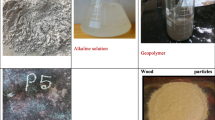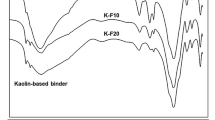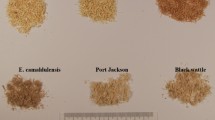Abstract
In this research, a new binder class for wood based composites, named geopolymer binder, was developed based on pozzolanic by-products (e.g. fly ash). Additionally, effects of different amounts of silica fume, as a replacement agent with other aluminosilicate components (e.g. fly ash and metakaolin), have been evaluated in the innovative binder. The Automated Bonding Evaluation System technique was used to characterize the bonding shear strength of the developed geopolymer binder. It was shown that the best shear strength for fly ash based binders was obtained by the lowest press temperature and longest pressing time. The addition of silica fume (from 20% up to 100%) significantly influenced the bonding shear strength in all binder types. Due to the chemical and mineralogical compositions, silica fume displays higher pozzolanic activity than metakaolin whereas fly ash shows lower strength in comparison to metakaolin. The silica fume (100%) based binder has also superior shear strength compared to those of conventional UF resin and other geopolymer binders. Bonding shear strength like that for UF resin was achieved by substituting only 20% silica fume in geopolymer binder compositions.





Similar content being viewed by others
References
Brew DRM, Mackenzie KJD (2007) Geopolymer synthesis using silica fume and sodium aluminate. J Mater Sci 42(11):3930–3993
Davidovits J (2008) Geopolymer chemistry and applications. 3rd edn, 2011: Institute Geopolymer, Saint Quentin, France
Dukarska D, Czarnecki R (2016) Fumed silica as a filler for MUPF resin in the process of manufacturing water-resistant plywood. Eur J Wood Prod 74(1):5–14
EN 450-1 (2012) Fly ash for concrete. Definition, specifications and conformity criteria. European Standard, Brussels, Belgium
Ferra JMM, Ohlmeyer M, Mendes AM, Costa MRN, Carvalho LH, Magalhaes FD (2011) Evaluation of urea-formaldehyde adhesive performance by recently developed mechanical tests. Int J Adhes Adhes 31:127–134
Gouny F, Fouchal F, Pop O, Maillard P, Rossignol S (2013) Mechanical behavior of an assembly of wood–geopolymer-earth bricks. Constr Build Mater 38:110–118
Gourley JT (2003) Geopolymers; opportunities for environmentally friendly construction materials. Conference on Adaptive Materials for a Modern society, Sydney, Institute of Materials Engineering, Australia
Heah CY, Kamarudin H, Mustafa Al Bakri, A M, Bnhussain M, Luqman M, Khairul Nizar I, Ruzaidi CM, Liew YM (2012) Study on solids-to-liquid and alkaline activator ratios on kaolin-based geopolymer. Constr Build Mater 35:912–922
Humphrey PE (1993) Device to test adhesive bonds. United States Patent, US005176028A. The State of Oregon Acting by and through the Oregon State Board of Higher Education on behalf of Oregon State University, USA
Lee WKW, van Deventer JSJ (2002) The effect of ionic contaminants on the early-age properties of alkali-activated fly ash-based cements. Cem Concr Res 32(4):577–584
Mai C, Militz H (2004) Modification of wood with silicon compounds. Inorganic silicon compounds and sol-gel systems: a review. Wood Sci Technol 37(5):339–348
Nagral MR, Ostwal T, Chitawadagi M (2014) Effect of curing temperature and curing hours on the properties of geo-polymer concrete. Int J Comput Eng Res 4(9):1–11
Olufemi FS (2013) Reactivity of cement combinations containing Portland cement, fly ash, silica fume and metakaolin. Int J Eng Res Appl 3(3):582–587
Pacheco-Torgal F, Castro-Gomes J, Jalali S (2008) Alkali-activated binders: a review. Part 2. About materials and binders manufacture. Constr Build Mater 22(7):1315–1322
Palomo A, Grutzek MW, Blanco MT (1999) Alkali-activated fly ashes. A cement for the future. Cem Concr Res 29(8):1323–1329
Pizzi A, Mittal KL (2003) Handbook of Adhesive Technology. Marcel Dekker AG, Basel
Provis JL, van Deventer JSJ (2009) Geopolymers; structures, processing, properties and industrial applications. Woodhead Publishing Limited, New Delhi, India, 454 p
Prud’homme E, Michaud P, Joussein E, Peyratout C, Smith A, Arrii-Clacens S, Clacens JM, Rossignol S (2010a) Silica fume as porogent agent in geo-materials at low temperature. J Eur Ceram Soc 30(7):1641–1648
Prud’homme E, Michaud P, Peyratout C, Smith A, Rossignol S, Joussein E, Sauvat N (2010b) Geomaterial foam to reinforce wood. Ceram Eng Sci P 31(10):3–10
Rashad AM (2013) Metakaolin as cementitious material: history, scours, production and composition—a comprehensive overview. Constr Build Mater 41:303–318
Sarmin SN, Welling J, Krause A, Shalbafan A (2014) Investigating the possibility of geopolymer to produce inorganic-bonded wood composites for multifunctional construction material—a review. BioResources 9:7941–7950
Shaikh FUA (2013) Review of mechanical properties of short fibre reinforced geopolymer composites. Constr Build Mater 43:37–49
Shalbafan A, Welling J, Hasch J (2016) Geopolymers as potential new binder class for wood based composites industry. Holzforschung 70(8):755–761
Thomas M (2013) Supplementary cementing materials in concrete. Taylor & Francis Group, CRC Press, Boca Raton
Wang K, Shah SP, Mishulovich A (2004) Effects of curing temperature and NaOH addition on hydration and strength development of clinker-free CKD-fly ash binders. Cem Concr Res 34(2):299–309
Wild S, Khatib JM, Jones A (1996) Relative strength, pozzolanic activity and cement hydration in superplasticised metakaolin concrete. Cem Concr Res 26(10):1537–1544
Xu H, van Deventer JSJ (2000) The geopolymerisation of alumino-silicate minerals. Int J Miner Process 59(3):247–266
Xu H, van Deventer JSJ, Lukey GC (2001) Effect of alkali metals on the preferential geopolymerization of stilbite/kaolinite mixtures. Ind Eng Chem Res 40(17):3749–3756
Zhaohu X, Yunping X (2001) Hardening mechanisms of an alkaline activated class F fly ash. Cem Concr Res 31(9):1245–9
Acknowledgements
The work presented was sponsored by Swiss Krono Group. The authors would also gratefully acknowledge the Wöllner GmbH and Ferropem companies for supplying materials.
Author information
Authors and Affiliations
Corresponding author
Rights and permissions
About this article
Cite this article
Shalbafan, A., Welling, J. & Hasch, J. Effect of aluminosilicate powders on the applicability of innovative geopolymer binders for wood-based composites. Eur. J. Wood Prod. 75, 893–902 (2017). https://doi.org/10.1007/s00107-017-1172-0
Received:
Published:
Issue Date:
DOI: https://doi.org/10.1007/s00107-017-1172-0




